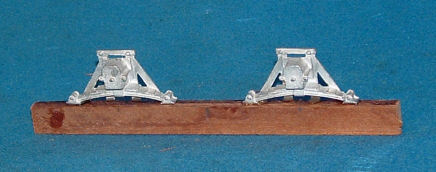

Further batches were purchased over time but records and photos have made the specific identification of the individual types difficult. I'm including the 2 vans here due to their numbering sequence, the Railway included them in their passenger stock returns. Uniquely for an English narrow gauge railway there were private owner wagons on the Southwold Railway, built and used by Thomas Moy, a coal dealer from Colchester.
These 8 wagons were purchased for the opening of the line from the Midland Railway Carriage & Wagon Company. They have the iconic raised rounded ends that aimed to keep the tarpaulins from sagging and pooling water.
Again purchased for the opening of the railway, these wagons still have dropping sides but have level ends.
These two wagons are sometimes referred to as timber wagons but have been photographed full of barrels.
Records do not reveal the original maker of these two vans but they were purchased in 1885. They are shown in almost every photograph of a train on the line so must have had the highest mileage of any piece of rolling stock. They were rebuilt to a larger size by English Bros. Ltd in 1918.
One of the van bodies (believed to be No.14) remains and is on display at the East Anglian Transport Museum near Lowestoft. You can find my pictures of this van here.
Purchased in 1892 it was originally thought these 3 wagons were similar to No.s 18 - 23 but a works photo is reputed to show no.16 as being a 4 plank wagon with flat ends but this never appears on any photos of the line. Given the number of photos with a 3 plank flat ended wagon in them, it is now accepted these three were of that type.
Ordered in 1894, again from Midland Railway Carriage & Wagon Company, these wagons were very similar to No.s 1 to 8 but had slightly lower ends.
Having seen the capabilities of these 6 wheel wagons first hand the Railway ceased adding 4 wheel wagons to it's fleet and purchased directly from Moys in 1896 (3 wagons), 1899 (6 wagons) and 1914 (4 wagons). In 1922 Moys sold two of its original three wagons to the railway (these becoming no.s 37 and 38) and in 1926 the remaining original wagon, this becoming no. 39. Whilst of the same general appearance batches of wagons differed in their door hinge and end support construction.
The only privately owned wagons on an English narrow gauge railway, these 6 wheel wagons were built by the coal merchant who operated them, Thomas Moy's works in Peterborough. The wagons were built on an under frame that utilized the Cleminson system of articulation where the outer two axles are able to pivot and the centre axle can move from side to side. This is the same system used by the coaches. Three wagons were on the line at, or soon after, the opening in 1879 these carrying the numbers 1507 to 1509 and lettered on the ends A,B & C, these were all eventually sold to the railway (see above). Two further wagons were added in 1922 – no.s 1510 and 1511, these being lettered D and E.
Sales from the old railway allowed me to purchase wheels, axleboxes and couplings for 8 wagons initially. Wood for these came from my existing stocks built up over time. Building 2 wagons takes little more time than one, building 6 wagons and two vans just a little longer!

Relevant sections of wood were sawn into floors, sides, ends, sole bars and buffer beams. Gradually the longditudinal planks of the floor were glued to the main floor, the latter first being scribed to show the flooring planks.

Sides were then glued to the edges of the floor, later ends were fettled to fit and then glued to make the solid box of the top of the wagon.


The axlebox castings were tidied up and then, using epoxy glue, were attached to the sole bars.
